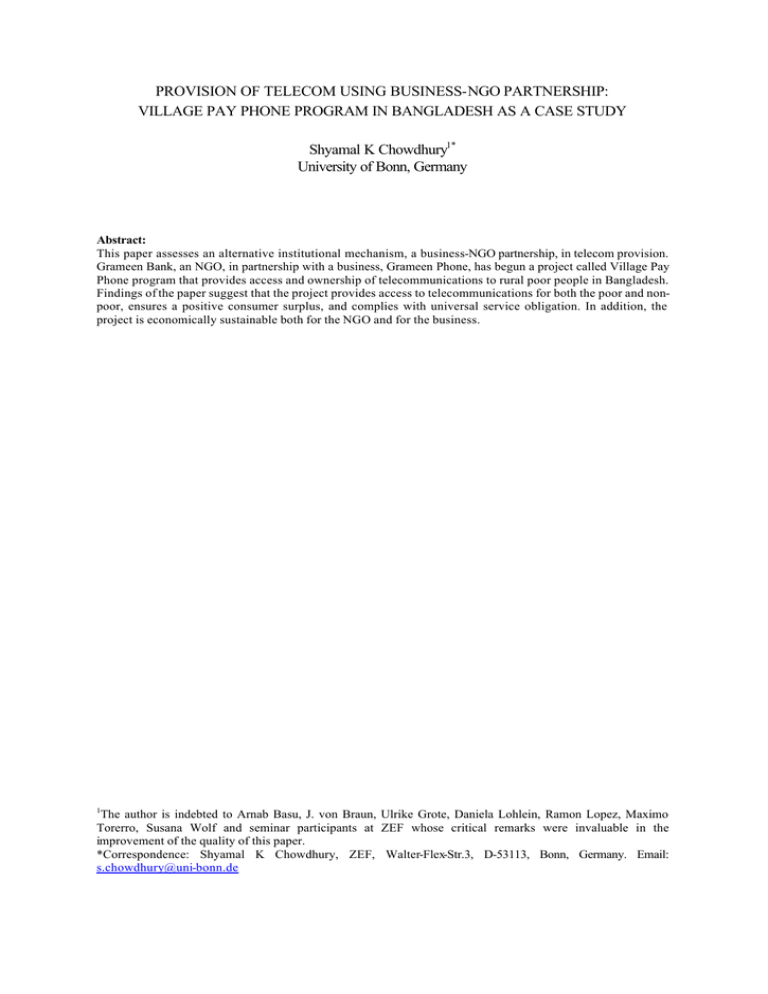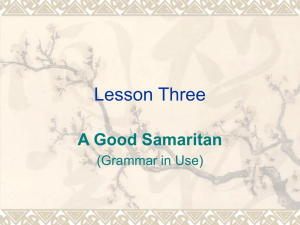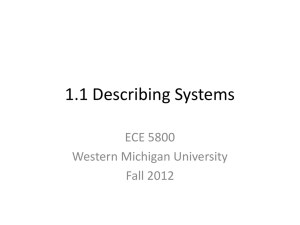PROVISION OF TELECOM USING BUSINESS-NGO PARTNERSHIP:
advertisement

PROVISION OF TELECOM USING BUSINESS-NGO PARTNERSHIP: VILLAGE PAY PHONE PROGRAM IN BANGLADESH AS A CASE STUDY Shyamal K Chowdhury1* University of Bonn, Germany Abstract: This paper assesses an alternative institutional mechanism, a business-NGO partnership, in telecom provision. Grameen Bank, an NGO, in partnership with a business, Grameen Phone, has begun a project called Village Pay Phone program that provides access and ownership of telecommunications to rural poor people in Bangladesh. Findings of the paper suggest that the project provides access to telecommunications for both the poor and nonpoor, ensures a positive consumer surplus, and complies with universal service obligation. In addition, the project is economically sustainable both for the NGO and for the business. 1 The author is indebted to Arnab Basu, J. von Braun, Ulrike Grote, Daniela Lohlein, Ramon Lopez, Maximo Torerro, Susana Wolf and seminar participants at ZEF whose critical remarks were invaluable in the improvement of the quality of this paper. *Correspondence: Shyamal K Chowdhury, ZEF, Walter-Flex-Str.3, D-53113, Bonn, Germany. Email: s.chowdhury@uni-bonn.de I. Introduction The present paper assesses an alternative institutional mechanism in telecom provision - a business-NGO partnership. Grameen Bank, an NGO, in partnership with a business, Grameen Phone, has begun a project called Village Pay Phone program, henceforth VPP program, that provides access and ownership of telecommunications to rural poor people in Bangladesh. Low teledensity in rural areas in developing countries is evident in general1 and in Bangladesh particularly so. One way to increase access is through market forces; increase in competitive market forces through privatisation can enhance efficiency, network extension and higher quality of services.2 However, market mechanisms alone are insufficient to ensure equity in access, and public ownership is no better either.3 As shown in table-A.1b in the appendix, despite the privatisation of rural telecom market in 1989 in Bangladesh, as of 1998, the telephone lines per 100 rural populations stood at 0.039. Telecom has public good like characteristics,4 and it is one of the basic components necessary to ensure access to information and communication technologies (ICT), which is widely recognized as strategic factor to reduce poverty and enhance development.5 Given the importance of universal access to telecommunications and the seeming failure of both public and private ownership to provide telecommunication services to rural people of developing countries, it is necessary to explore alternative forms of ownership and institutions. Against this backdrop, we evaluate a partnership project in rural telecom provision, the VPP program, where business and NGO provide complementary inputs for the success of the project. The paper proceeds as follows: section 2 develops an analytical framework. Section 3 describes the VPP program, section 4 describes the empirical findings and section 5 concludes. II. The analytical framework There are two specific questions related to universal access to telecommunication: first, policy needs to determine the minimal level of acceptable service for all users; second, public authority needs to ensure access of all users, either through direct provision, or through regulation of private providers, or a combination of both. However, in the absence of dramatic changes in public expenditure policy, the notion of universal access for the people living in 1 See table-A.1a in the appendix. Gasmi et al., 2000. 3 For empirical evidence see Torero, 2000. 4 See Leff, 1984. for a detailed discussion. 5 For example, see Okinawa Charter, 2000. See also Morales-Gomez and Melesse, 1998. 2 2 rural areas would remain unmet in the near future. Market based private providers might not offer the best alternative to a state, or a state-based monopoly for rural areas in particular, as market based solutions might result in underprovision. One reason for underprovision of telecommunications in rural areas under market condition is ineffective demand, as per subscriber revenue might not support network extension. However, it does not imply that the extension of telecommunication network in rural areas does not generate any positive consumer surplus. In fact, it is possible that despite higher willingness to pay per call by a rural subscriber compared to that of an urban subscriber, the rural area might remain underprovided. The figure below explains such circumstances more vividly. Number of Call WTP Per Call 0 0´ Poor, Rural Rich, Urban TCS Per sub. MC Per sub. E CS Per call 0 Poor, Rural N* 0´ Rich, Urban Figure-1: Telecom network under market provision Figure-1 has two panels where the upper panel of the figure could be viewed as an outcome of the lower panel. The upper panel combines willingness to pay (WTP) per call and number of call per subscriber (sub.), while the lower panel combines underlying consumer surplus (CS) per call and total consumer surplus (TCS) per subscriber (sub.). In the lower panel, the TCS curve can be viewed as the individual demand curve, as well as total willingness to pay per subscriber, and the dotted line is the marginal cost of telecom provider which is assumed here as constant per subscriber. The two corners of the horizontal axis of both of the panels 0 and 3 0´ can be viewed either as income dimension, or as rural-urban dimension, or both. Here 00´ represents total population. Despite the higher CS per call and associated willingness to pay of a poor/rural subscriber than that of a rich/urban subscriber, as shown in figure-1, a private telecom provider cannot extent its network beyond 0´N* as the marginal cost (MC) of network extension is lower than the total consumer surplus and associated total WTP of such subscriber. That means, out of a total of 00´ population, the competitive market extends the network up to 0´N*, leaving 0N* population without a telecommunications network due to the ineffective demand. To overcome the ineffective demand, that is the inadequate revenue per subscriber, one possible solution is to sum up the individual demand; demand of individuals left of N* could be summed up and subdivided in such a way that every individual is included in the network while the marginal cost of inclusion of such a subscriber is less than, or equal to, the marginal revenue from that subscriber. Solutions that are widely used in reality to address part of the 0N* are telephone booths and public call centres. However, as can be seen from the experiences of many developing countries, network extension through telephone booths and call centres have also remained under provided.6 Business-NGO partnership: An NGO differs from a business (and public) organizations in two ways: first, in its concern for increasing the supply of public goods,7 second, in its informational advantage; due to its local level knowledge, it can overcome the imperfect information problems that exist in the rural areas. Now in order to extend access beyond N*, the partnership can set up telephone booths where individual demand can be summed up, or it can establish call centres. For simplicity, we assume that due to the higher operating and maintenance cost, setting up telephone booths is not a viable option. Therefore it opts for the call centre and establishes it under private ownership. In addition, as it wants to ensure access of the rural poor in particular, it selects only poor individuals as owners/operators of the call centres as a result. When a business alone wants to ensure access of rural poor people to telecommunications utilizing the same mechanism, it faces all three classical problems of imperfect information: screening, incentives and enforcement problems in selecting private owners/operators for its 6 For instance, in Bangladesh, as of 1998 the number of populations per public telephone including call center was 50,000. (Source: ITU data set). 7 For economic contribution of NGOs, see Salamon and Anheier, 1998; for innovative service delivery, see Badelt, 1985; and for public good motive, see Roy and Ziemek, 2000. 4 centres. Due to the difference in the likelihood of performance of different individuals, it is costly for a business to evaluate the risk associated with each individual and design a different contract accordingly. This high cost argument is true for the other two too; it is costly for a relatively new entry to design incentives for the individuals to maximize the payment likelihood, and enforcement of contract in a rural setting for such entity could prove to be difficult and costly too. However, an NGO with local level knowledge and interlinkages with other market does not face the problems stemming from imperfect information. Access to network under partnership: Given the above background, it is now possible to formalize the problem. The problem is to maximize the number of persons, n, that have access to the telephone subject to the restrictions that it does not reduce the number of persons that have access when the market acts alone. Other restrictions are the joint production possibility of the business and of the NGO, and revenue and cost considerations. The problem, then, is as follows: Maximize N (n) (1) Subject to: N ( n) ≥ N * (2.1) F ( y, z) = 0 (2.2) R(n ) ≥ C ( y, z ) (2.3) Here, N (.) , is the number of individual that have access to telephone. Equations (2.1) to (2.3) are the constraints: (2.1) restricts the total access to at least at the market provided level, (2.2) is the joint production function where y and z are the inputs of the business and NGO respectively, and (2.3) is the revenue and cost restriction which can be viewed as resource constraint as well. The objective and the constraints can be combined in the Lagrangian expression: L = N (.) + λ [N ( n) − N *] − µ F ( y, z) − ω [R ( n) − C ( y, z )] (3) Differentiating with respect to n, y, and z, and assuming no corner solutions, we obtain the first order condition (f.o.c) for a maximum: λN ′( n) − ωR′(n) = 0 (4.1) − µFy ( y, z ) + ωCy ( y , z ) = 0 (4.2) 5 − µFz ( y, z) + ωC z ( y, z ) = 0 (4.3) The first order condition (4.1) shows the marginal subscriber and the revenue from that subscriber. Conditions (4.2) and (4.3) show the marginal product and marginal cost of the business and NGO respectively, where Fy , C y , Fz , Cz are the respective partial derivatives. The f.o.cs imply that the marginal cost that both the business and the NGO incur in order to ensure the inclusion of the marginal subscriber need to be less than, or equal to, the marginal revenue from that subscriber. III. Village pay phone program under partnership To address the issue of rural peoples’ access to telecommunications, Grameen Bank (GB) and GrameenPhone (GP) have founded a joint project called the village pay phone (VPP) program. It is a partnership between GB and GP. GB, through its wholly owned subsidiary, Grameen Telecom (GTC), and in collaboration with GP, allows female borrowers of the Bank's credit program to become the owner-operators of mobile phones under the VPP program, where GP offers access to the network at a discounted rate, and GB operates and manages the project. GB is a not-for-profit organization that provides formal credit to rural poor women without requiring any direct collateral, known as group lending.8 As of February 2000, the bank had 2,355,985 borrowers of which 94.77% were female. At its current state, the bank covers around 58.61% of all the villages9 in Bangladesh. As a policy, Bank's staff travel everyday to the doorsteps of its borrowers and collect weekly instalments.10 GB’s focus on information and communication technologies could be found in the establishment of three sister organizations: Grameen Communications, Grameen Cybernet and Grameen Telecom. GP is a business organization that provides cellular mobile phones in Bangladesh. GP is a joint venture company that has four shareholders; with a 35% stake GTC is one of its shareholders. As a part of its operation, GP establishes networks, operates, and provides telephone connections. Under the VPP program, GTC provides cellular phones to the selected borrowers of GB. The members purchase the phone under the lease program of the Bank and make the telephone available to other villagers. Here each VPP owner-operator acts like a public call office 8 See Stiglitz, 1990, on group lending. Villages are rural settlements and usually characterized by inadequate or absence of infrastructure in general. 10 See http://www.grameen-info.org/bank/supdates.html 9 6 (PCO); she re-sells phone calls, provides message services within the village, and lets others receive incoming calls. Table-A.2a in the appendix shows the growth of VPP over the years. By 2004, GTC plans to extent the program to all 68,000 villages of Bangladesh. In addition, GTC has a plan to add other products like fax and email services to the VPP program at a later stage. The screening and selection process of VPP owner-operators: GB staff select VPP owneroperators exclusively from among credit group members. In the selection process, GB uses financial criteria, such as borrower’s track record of credit and repayments regularity, and financial solvency, such as type of business and flow of income. The technical requirements that GB seeks are literacy, particularly familiarity with Roman numerals; availability of electricity connection in the house; and the centrality of the operator’s location within the village. In addition, GB also checks whether a potential operator is willing to offer the service around the clock and go to users’ doorstep to provide message services within the village. Based on these criteria GB staff and members of its credit group jointly select one VPP owner-operator for each village. GB extends credit for the selected VPP owner-operator through its lease program, and the group as a whole remains liable for the credit. As a part of the program, GTC trains the operators and handles all service related issues, while GB collects the bill and monitors the VPP operators through peer monitoring.11 Pricing policy: GTC buys bulk airtime rate from GP at a discounted rate and passes it to the VPP operators. VPP owner-operators pay at the same rate that GTC pays GP. In addition, operators also pay 13% on the airtime charge, to cover GTC’s overhead costs and GB’s collection costs. VPP owner-operators also charge different rate for incoming call depending on the type of call. It is important to note that the users who make calls from VPP pay at the same rate that other private GP subscribers pay. That means, under a given circumstances, a person willing to make a call is indifferent between calling from a VPP or making a call from his/her private mobile phone (when s/he is a direct subscriber of GP’s mobile phone). The technical side of the program: The railway fibre optic that GP uses as a backbone of its physical network covers a distance of around 12 kilometres from any point of the network. Villages after 12 kilometres require additional antennae, and hence additional investment. For such villages, GTC supplies the antenna, GB extends extra credit, and VPP owner-operators pay additional instalments. However, GP does not commit any additional investment. Table- 11 See Besley et. al., 1993, on peer monitoring. 7 A.2b in the appendix shows the different components of price of the VPP packages including the price of antennae over time. IV. Empirical Findings There are two specific aspects of the VPP program that need to be examined. The first one is the public good objective: whether the VPP program increases the access of poor/rural people to telecommunications. To evaluate this, the distribution of phone users with respect to income is examined. The second aspect is economic sustainability. One way to evaluate it would be to examine whether the project satisfies the conditions described in equations (4.1) to (4.3). More specifically, we ask the following questions about the project: 1. Does it create a positive surplus for the VPP users? 2. Is it a profitable venture for the providers, namely for GP, GTC, GB, and VPP owneroperators? To answer these questions, we estimate consumer surplus and demand for telephones of the VPP users. For the providers, we quantify the profit of associated parties where possible, and make predictions for the others where quantitative figures are unavailable. Data: The empirical findings are based on two primary surveys conducted by Jahangirnagar University (JU), and the Centre for Development Research (ZEF). The first survey was conducted in June-August 1998; it included 50 VPP owners-operators and 356 users. The second survey was conducted in June-August 2000 and followed up part of the 1998 survey sample; it included 100 users and 24 VPP owners-operators. For identification purpose, we call the second one sub-sample as it covers part of 1998 sample only. IV.A Users of VPP program Distribution of users: We have classified the entire 1998 sample into two income groups: poor, and non-poor based on per day calorie intake. A per capita intake of less than, or equal to 2122 calories per day are classified as poor, and more than 2122 calories per day as nonpoor respectively.12 Table-1 reports the distribution of users of VPP. According to this classification, 15% of the users of VPP fall into poor category. However, in terms of total number of phone calls, the poor made 21,5% of total VPP calls. 12 See Bayes et. al., 1999, for detailed. 8 Table-1: Distribution of users by economic status and usage Poor Number of users 55 (15.4%) Number of call per week 192 (21.5%) Non-Poor 301 (84.6%) 699 (78.5%) Consumer surplus of VPP users: Consumer surplus is one of the most widely used methods to measure the benefits that a particular project accrues to its users. Saunders, et. al. (1994) mention three approaches to measure the consumer surplus of a telecommunication project in a developing country context: a) price change method, b) the best-alternative method, and c) the expenditure method. Here, we chose the second one; the rationale behind choosing this method over the other two is based solely on the availability of micro level data on the project. The best alternative method compares the cost of two methods: cost carrying out a given activity using telecommunications and the cost of best-alternative means of communication. Table A.4a in the appendix report the alternative means of communication and table-2 reports the associated consumer surplus. Table-2: Consumer surplus, VPP vis -à-vis best alternative. Economic Time required in Transport Opportunity Status alternative cost cost of time methods (hours) Poor 3.67 60.89 34.32 Non-poor 2.54 45.80 21.71 Entire sample 2.70 48.02 23.57 Total cost of best alternative 95.21 67.51 71.58 Total cost of VPP 17.35 16.73 16.82 Consumer surplus 77.86 50.78 54.77 It may be worthwhile to note the relatively higher consumer surplus reaped by the poor income group; due to the lack of an alternative, and scarcity of information, it seems plausible that information is more costly for the rural poor than for the non-poor. In addition, table-A4b in the appendix presents consumer surplus calculated from the sub-sample; as can be seen from the table, there has been a positive change in consumer surplus over the two-year period. Demand for village pay phone: Suppose that each user’s (Marshallian) demand for telephone is given by the following function: Q = F (P t , P a , Y , X ) (5.1) Where Q is the demand for telephone, P t and P a are the prices of telephone and its alternatives respectively, Y is income, and X denotes personal characteristics. Following Foster and Hahn (2000), the corresponding log linear demand system of (5.1) that is linear in parameters can be written as 9 q = α + β 1 pt + β 2 p a + β 3 y + µ j X j + ε i ; j = 1....k (5.2) Where q, pt , pa and y denote the logarithms of quantity demanded, cost for access to telephone, cost of best available alternative of telephone, and household income respectively. Here, X j denotes household specific characteristics that include household size, gender of the household’s head, age, education, and occupation. The logic behind inclusion of household specific characteristics instead of individual user’s characteristics is due to the fact that in developing countries many economic outcomes, e.g. income and expenditure are measured largely at household level and it is difficult to attribute portions of that to individual members.13 Here ε i is a random taste shock uncorrelated to household’s characteristics and alternatives. Table-A.5a and A.5b in the appendix provide summary statistics of the variables included in the estimation. Here, the cost of telephone and cost of alternative include cost of telephone or its alternative, as well as travelling cost and the opportunity cost of travelling. Considering the frequency distribution, we have categorized education of the household head into two categorical variables: illiterate-literate, and schooling-below-secondary and secondary-andabove. Similar to education, two major categories in case of occupation of the household head are agriculture and business, and we have converted it into two categorical variables: agriculture non-agriculture, and business non-business as a result. Table-3 reports estimated coefficients from the cross-section and panel data. Here, parameters are estimated using ordinary least squares (OLS) method. With the exception of education of the household head, the significance of all other estimated coefficients remains same over the period. As the table reports, the coefficient of cost of telephone is not significant, the coefficient of cost of best available alternatives of telephone is significant and positive; given the cost of telephone, as the cost of alternative increases, the probability of using telephone increases too. 13 See Jollifee, 1998, and the references therein. 10 Table-3: Coefficients of the demand for telephone call Dependent variable: Total number of call made per week. Variable Coefficients, 1998 Constant -0.075 (2.315) Cost of telephone call -0.033 (0.028) Cost of best available alternative 0.305** (0.037) Total household income 0.037 (0.020) Age, head of the HH -0.793 (1.197) Age square, head of the HH 0.103 (0.156) Household size 0.221** (0.053) Gender: Female 0, male 1 0.003 (0.061) Education: Illiterate 0, and others 1 -0.171* (0.055) Education: Below secondary 0, others 1 0.269** (0.051) Occupation: Agriculture 0, others 1 -0.044 (0.056) Occupation: Business 1, others 0 0.297** (0.049) R-squared 0.626 Adjusted R-squared 0.608 Probability (F-statistic) 0.000 Included observations 241 Panel 1998-2000 -6.925 (3.813) 0.009 (0.033) 0.386** (0.038) 0.049 (0.030) 2.644 (1.969) -0.381 (0.258) 0.313** (0.079) 0.089 (0.094) 0.203* (0.088) -0.096 (0.075) -0.084 (0.084) 0.205* (0.068) 0.522 0.493 0.000 194 Numbers in the parenthesis are the standard errors. **, * show level of significance at 1% and 5% respectively. Regarding household characteristics, variables that have significant impact include household size and head of the household’s education and occupation. While household size has a positive impact implying that larger households have a higher probability of using more telephones instead of traditional alternatives, households with business as a source of income also have a higher probability of using telephones as well. Education of the head of the household has contradictory sign; while literacy does not have positive impact in the 1998 sample, over time it appears to be both positive and significant. Total yearly household income is not significant at the 5% level. Here, the usual assumption is that income is exogenous. It implies that under the present institutional environment where VPP operates, income is not a significant determinant of telephone use. In fact, we have seen in the distribution of users (Table-1) that similar to the non-poor, poor people are also users of 11 VPP and average consumer surplus (Table-2) of the poor as a group is higher than that of the non-poor. IV.B Providers of the VPP program VPP owner-operators: For this group, we rely on the same survey data that we have utilized to measure consumer surplus. Table-3 provides the mean and standard deviation of weekly profit per owner-operator, total revenue and its distribution according to sources, expenditures and instalment payments. Table-A.8a: Distribution of weekly profit, revenue and expenditures of VPP operators (in Tk.) Mean Std. Deviation Estimated Profit 591.29 213.92 Total Revenue from calls 1076.82 417.92 In calculating profit, we have taken the labour cost, interest payment and depreciation in addition to the airtime and service charge payment into account. Depreciation is estimated as 10% per year on the total payment that a VPP operator needs to make, and interest rate is assumed to be 23% per year. With a mean profit of Tk.591.29 per week, that can vary from as low as Tk. 230 to as high as Tk. 1149, the VPP ensures a positive return to its operators. Note that in a country like Bangladesh, where per capita income is US$270, the reported mean profit of US$615 is an attractive return to a family that lives close to the poverty line. In addition, table-A.6 in the appendix reports the change in weekly revenue and profit; this shows that the VPP has remained a permanent income source for the owners-operators over the period. GrameenPhone (GP): GP does not incur any additional investment for VPP program; it offers a discounted rate access for the VPP owners-operators. Despite this lower rate, the VPP program ensures a positive marginal return to GP. Two specific reasons that explain this apparent contradiction are: high airtime usage of VPP, and minimum operating cost. As mentioned in GP’s annual report 1999, the average airtime usage of VPP is more than double of a typical business user in urban areas. As GB takes care of the whole operating and collection issues, GP treats the whole VPP program as a single user and incurs a minimum operating cost only. Therefore, as written in GP’s annual report 2000, even with discounted prices, the VPP program has proven to be a profitable business for it. GB and GTC: For GB, the new program neither requires any significant physical investment, nor increases its operating cost, as GB does not expand its office network or human resources due to the VPP program. As of December 2000, GB has earned a net profit of Tk. 867,000.00 12 from the VPP program. Though, the exact figure for GTC is not known, the VPP program is a profitable venture for it as well. IV.C Economics of business-NGO partnership Two aspects that deserve particular attention in the light of business-NGO partnership are the cost and information aspect, and the price and welfare aspect. Cost and information aspect: To extend the telecom network in the rural area at an affordable price, it is necessary to create effective demand without increasing the marginal cost. For the first task, to create new subscriber, the partnership has transformed the characteristics of the product; it has transformed the phone from a consumption to a production good and offers it to a class of subscribers, VPP owner-operators, who otherwise would not demand it. In addition, it also offers credit through the GB’s lease program to this new class of subscribers so that they can finance their new investment. For the second task, to keep marginal operating cost at a constant level due to additional subscriber, the partnership uses GB’s existing network that keeps the operating and collection cost at minimum. Regarding the role of information, selecting the right VPP operator is a critical step in the program as both economic and social objectives depend crucially on the operator’s performance. As the program selects from GB’s borrowers only, it does not face problems related to imperfect information, as borrowers are well known to GB. In addition, as GB has credit linkage with VPP operators, monitoring the performance and implementing contract is relatively cheap. Price and welfare aspect: VPP program ensures price equality between both urban and rural areas, and between both subscribers and non-subscribers. One of the most important aspects of this uniform pricing is the compliance with the universal service obligation (USO). Though the definition of USO is mostly country specific, ‘a USO is typically viewed as the obligation of an operator to provide to all users a ‘basic’ package of services of ‘good’ quality and at ‘affordable’ prices’.14 In addition, a USO is a form of regulation that puts restrictions on pricing policies, and many countries act to ensure access to the universal service at a uniform price.15 Though not required by the regulator of the country concerned, coincidently VPP program meets the universal service obligation. 14 15 See Valletti, 2000. See Gasmi et. al., 2000. 13 In addition, an urban subscriber of GP, if s/he wants so, cannot make business out of reselling call services to customers in a rural area that has a VPP operator. This, in turn, ensures VPP as a business and VPP operator as a producer and seller of information services, and other subscribers (only GP subscribers in this case) as mostly the consumer of information. V. Conclusion Though the role of telecommunication is widely recognized as an important factor in reducing poverty and enhancing development, ensuring the access of rural poor to the telecommunications network has remained a growing challenge for policy makers in developing countries. Despite privatisation of telecom services in developing countries, rural areas may not get access to telecom due high operating costs and ineffective demand. Under these circumstances, the business-NGO partnership offers an alternative approach in providing the rural people including poor with access to telecommunications services. The basic premise that motivates GB to undertake the VPP program is a desire to increase the supply of public goods, and to increase income and welfare of its group members. As the findings suggest, the project provides access to telecommunications for both the poor and non-poor, ensures a positive consumer surplus, and complies with universal service obligation. In addition, the project is economically sustainable both for the NGO and for the business. Apart from the case study described above, the NGO-Business partnership has many potential implications. One further research interest in the present context could be the content creation. The present World Wide Web (WWW) acts as a cost efficient source of ideas and resources. However, it is lagging behind in offering resources in the local context of developing countries, and one probable application of business-NGO partnership would be local level content creation. 14 References Bayes A, Von Braun J. 1999. Village Pay Phones and Poverty Reduction: Insights from a Grameen Bank initiative in Bangladesh. ZEF Discussion Paper 8, Bonn University. Badelt C. 1985. Politische Ökonomie der Freiwilligenarbeit: Theoretische Grundlegung und Anwendungen in der Sozialpolitik. Campus Verlag, Frankfurt/Main. Besely T. Coate P. Loury G. 1993. The Economics of Rotating Savings and Credit Associations. American Economic Review 83, 792-810. Foster A. Hahn J. 2000. A Consistent Semiparametric Estimation of the Consumer Surplus Distribution. Economics Letters 69, 245-251. Gasmi F. Laffont JJ. Sharkey WW. 2000. Competition, Universal Service Obligation and Telecommunications Policy in Developing Countries. Information Economics and Policy 12, 221-248. Grameen Phone. Annual Reports, 1999, 2000. Jolliffe D. 1998. Skills, Schooling, and Household Income in Ghana. The World Bank Economic Review 12, 81104. Leff NH. 1984. Externalities, Information costs, and Social Benefit-Cost Analysis for Economic Development: An example from Telecommunications. Economic Development and Cultural Change 32, 255-276. Melody WH. 2000. Extending the limits of telecom markets. Telecommunications Policy 24, 279-80. Morales-Gomez D. Melesse M. 1998. Utilising information and communication technologies for development: The social dimensions. Information Technology for Development 8, 3-13. http://www.dotforce.org/reports/it1.html. 2000. Okiniwa Charter on Global Information Society. Roy K. Ziemek S. 2000. On the Economics of Volunteering. ZEF-Discussion Paper 31, Bonn University. Salamon LM. Anheier HK. 1998. The Emerging Sector: An Overview. The John Hopkins University, Baltimore. Saunders R. Warford JJ. Wellenius B. 1994. Telecommunications & Economic Development. Johns Hopkins University Press: London. Stiglitz JE. 1990. Peer Monitoring and Credit Markets. The World Bank Economic Review 4, 351-366. Torero M. 2000. The Access and Welfare Impacts of Telecommunications Technology in Peru. ZEF Discussion Paper 27, Bonn University. Valletti TM. 2000. Introduction: Symposium on Universal Service Obligation and Competition. Information Economics and Policy 12: 205-210. http://www.grameen-info.org/bank/supdates.html 15 Appendix Table-A1a: Telephone lines per 100 populations, 1995 In urban area High income countries 51.7 Low income countries 5.2 Source: ITU Rest of the country 48.5 0.7 Table-A.1b: Access to Telecommunication in Bangladesh: Urban-Rural Distribution 1980 1990 1995 1998 Share of rural area as a % of total telephone 8.83 10.50 8.90 8.90 Telephone lines per '00' rural population 0.015 0.031 0.036 0.039 Telephone lines per '00' urban population 0.680 1.175 1.640 1.735 Source: Bangladesh Bureau of Statistics Table-A.2a Growth of VPP over the years Year Number of VPP 1997 1998 1999 2000 2001 (March) Growth (in %) 28 179 1114 3085 4166 Table-A.2b: Prices of Village Pay Phone (VPP) Package over the time in Tk. Time period Basic Package Antenna* 1997-98 18100 1999-Feb’2000 15000 March-April 2000 17000 May-Dec. 2000 15000 *If necessary. 539.29 522.35 176.93 35.04 6500 4500 5000 5000 Mobile Set Nokia 1610 Nokia 1610 Nokia 8110 Nokia 5110 Table-A.4a: Alternative means of communication to VPP (users’ response in %) Alternatives to VPP Poor Non-poor Would not try 0.00 Use other telephone outside the village 32.73 Post office 5.45 Have to go/hire person to go 61.82 Other means 0.00 Total 100.00 Table-A.4b: Consumer surplus (in Tk), 1998-2000 (sub-sample) Variable 1998 Mean Std. Deviation Exp. on Telephone 97.60 252.46 Exp. on Alternative 180.20 167.65 Total Weekly call 2.44 1.01 Consumer surplus 82.60 259.57 Table-A.5a: Summary Statistics (in Tk.) Variable a Mean Total number of call made per week Cost of telephone call Cost of best available alternative Total household income (yearly) Household size Age, head of the household a All variables are expressed in natural logarithm. 2.3 43.0 6.8 47.3 0.6 100.0 2000 Std. Deviation Mean 64.08 254.17 2.97 190.09 71.41 189.02 1.45 179.47 Standard Deviation 0.73 3.87 4.99 11.62 1.72 3.82 0.44 1.30 0.98 0.99 0.39 0.30 16 Table-A.5b: Categorical Variables, head of the household Education Frequency Illiterate 29 Can sign only 45 Up to Class 5 44 From 6 to Class 10 67 SSC and above 57 Total 242 Occupation Household work 44 Farming own land 50 Agriculture, non-crop 2 Rural industry 2 Agriculture labour 5 Non-agriculture labour 2 Transport 5 Govt. /private service 44 Business/trade 88 Total 242 Sex Female 33 Male 209 Total 242 Percent 12.0 18.6 18.2 27.7 23.6 100.0 18.2 21.7 0.8 0.8 2.1 0.8 2.1 18.2 36.4 100.0 13.6 86.4 100.0 Table-A.6: Weekly revenue and profit of VPP owners-operators (in Tk.), 1998-2000 (sub-sample) Change, 1998-2000 Mean Std. Deviation Revenue 1575,80 2233,28 Profit 1314,80 2115,68 17





